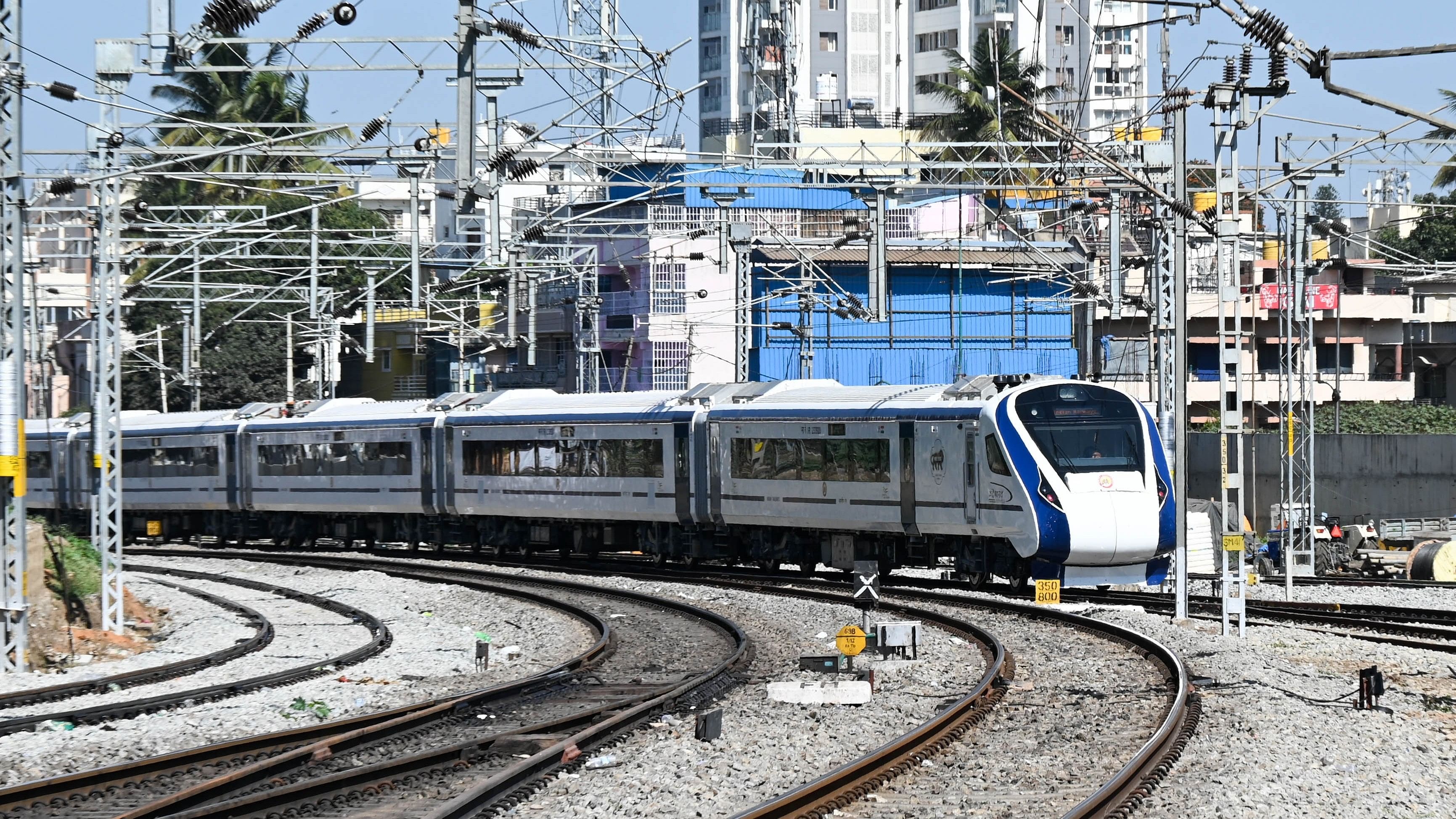
The Vande Bharat Express chugs into the Bengaluru Cantonment railway station during its recent trial run.
Credit: DH PHOTO/BH SHIVAKUMAR
In the Interim Budget 2024–25, the Indian Railways received a 5.8% year-on-year increase with key focus areas specified. A highlight was the news that 40,000 train coaches were to be transformed to Vande Bharat standards. Why this disproportionate attention
to rolling stock when the focus should first be on track infrastructure?
Notably, the ‘Mumbai-Ahmedabad bullet train’ corridor project is making significant progress with the completion of 100 km of viaducts, 230 km of pier work, and building bridges over six rivers. The rolling stock of 24 E5 Series Shinkansen train sets is yet to be procured from Japan. The development of dedicated high-speed rail infrastructure, tracks, stations, and signalling systems to support the operation of these trains is a critical component of the bullet train project and is taking precedence over the acquisition of rolling stock.
Similarly, in Bengaluru’s Namma Metro Phases 1, 2, 2A, 2B, and 3, which are fully commissioned, under implementation, and in the planning stage, respectively, metro construction and metro infrastructure, including tracks, stations, and signalling systems, take precedence over procuring rolling stock from metro coach makers like BEML. Only because rolling stock comes after infrastructure sequentially, Bengalureans today are putting up with delays in supply of Chinese coaches that are to be used on Namma Metro’s purple, green, and yellow lines.
Why, then, in the case of the Vande Bharats, are we putting the ‘cart before the horse’, clamouring for rolling stock before laying new tracks, doubling the number of lines on existing routes, and deploying automated train safety technology—the indigenously developed Kavach warning system—to guard against on-track collisions? We know the Vande Bharats have a design speed of 180 km/h but operate at a maximum of 130 to 160 km/h for very brief stretches en route, primarily because of restrictions related to signalling, track infrastructure upgrades, and fencing.
As of January 2024, 82 Vande Bharat trains are already in operation. I travelled on Vande Bharat’s Bangalore-Mysuru route and, on the way back, took a Shatabdi. The Shatabdi was as good as the Vande Bharat when it came to comfort. No doubt, the Vande Bharat’s acceleration due to the powering of every second coach was better; the jerks were lesser because four power units are distributed across the train; and the riding comfort was greater with fewer jerks as compared to the Shatabdi. Additionally, the Shatabdi needed to operate its brakes earlier and took longer to regain maximum speed; the higher acceleration and faster braking no doubt helped the Vande Bharat cut short travel time by 10–15 minutes.
The Vande Bharat unfortunately compromises on the number of toilets, with a curved bathroom door that’s difficult to close. On the Bidadi to Mysuru stretch, the train, with its aerodynamic design, automatic doors, one-touch lights, plush interiors, and a TV screen that repeatedly screened the inauguration and ‘flagging off’ of more Vande Bharats, mostly operated at 98 km/h! Yes, it did touch 100 km/h, but only for a brief minute or so during the entire journey. I asked the bearer, who was serving tea to passengers, whether he noticed any difference in the two trains; except for reaching earlier, the rest was all the same, he said.
While the Vande Bharat is tested for 180 km/h and the Shatabdi is tested for 160 km/h, both trains are in equal need of track upgradation, signalling systems, and infrastructure, which is currently a work in progress. At almost half the cost of Vande Bharat, the Shatabdi Express, due to its use of Linke Hofmann Busch (LHB) coaches, has the capability of achieving 160 km/h. When track up-gradation is going to take another decade, how can either train breach the 160 km/h limit except on limited stretches? Why then upgrade to Vande Bharat standards by dumping the Shatabdis when there is a scope to save 50% costs by letting the Shatabdis run?
There’s so much excitement because more Vande Bharat variants, including sleepers, metros, and freight trains, are to follow. Why is similar enthusiasm lacking for track up-gradation and infrastructure? Why prioritise rolling stock before attending to infrastructure upgrades? Is it because it constitutes the less glamorous part of railway activity? Instead of turning the Vande Bharat story into a public relations and event management exercise, shouldn’t the railways first exploit the Vande Bharat to full speed, giving passengers not only a good travel experience but also a substantially reduced travel time between destinations?
(The writer is a former
Executive Director and Member, Board of Directors, BEML)